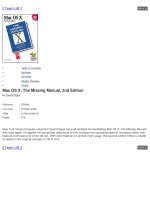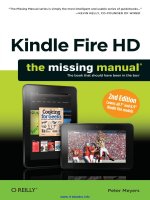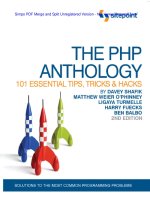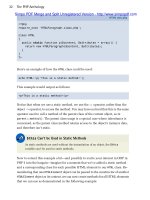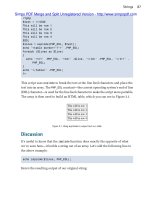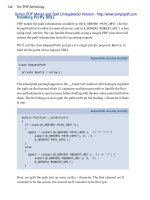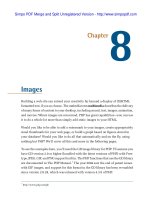The passionate programmer, 2nd edition
Bạn đang xem bản rút gọn của tài liệu. Xem và tải ngay bản đầy đủ của tài liệu tại đây (1.21 MB, 218 trang )
www.it-ebooks.info
Prepared exclusively for Alison Tyler
www.it-ebooks.info
What Readers Are Saying About The Passionate Programmer
If you are passionate about software craftsmanship, if you want to
be a great software developer, if you want to love your work, or if
you want to raise the bar and turn software development into a profession instead of a job, then read this book. In these pages, Chad Fowler
presents a set of no-nonsense heuristics, disciplines, and attitudes that
will teach you how to respect and love your profession—and be great
at it.
Bob Martin
President, Object Mentor, Inc.
The great thing about this book is that it is full of plans—things I can
do. It keeps responsibility for my situation where it belongs—on me.
This book makes it clear that I’m not alone, it shows that my situation
is not uniquely scary, and it explains what I can do today. And tomorrow. And for the rest of my career.
Kent Beck
Programmer
Six short months before I read Chad’s book, I was on the verge of
changing careers. Through a series of accidents from November to
May, I decided not only to stick with software development but to be
passionate about it while striving to be great. With a healthy dose of
inspiration, the book you’re now holding served as a road map for
achieving those goals.
Sammy Larbi
Chief Spaghetti Coder, codeodor.com
Prepared exclusively for Alison Tyler
www.it-ebooks.info
The Passionate Programmer
Creating a Remarkable Career
in Software Development
Chad Fowler
The Pragmatic Bookshelf
Raleigh, North Carolina
Prepared exclusively for Alison Tyler
Dallas, Texas
www.it-ebooks.info
Many of the designations used by manufacturers and sellers to distinguish their products are claimed as trademarks. Where those designations appear in this book, and The
Pragmatic Programmers, LLC was aware of a trademark claim, the designations have
been printed in initial capital letters or in all capitals. The Pragmatic Starter Kit, The
Pragmatic Programmer, Pragmatic Programming, Pragmatic Bookshelf and the linking
g device are trademarks of The Pragmatic Programmers, LLC.
Every precaution was taken in the preparation of this book. However, the publisher
assumes no responsibility for errors or omissions, or for damages that may result from
the use of information (including program listings) contained herein.
Our Pragmatic courses, workshops, and other products can help you and your team
create better software and have more fun. For more information, as well as the latest
Pragmatic titles, please visit us at
Copyright © 2009 Chad Fowler.
All rights reserved.
No part of this publication may be reproduced, stored in a retrieval system, or transmitted, in any form, or by any means, electronic, mechanical, photocopying, recording, or
otherwise, without the prior consent of the publisher.
Printed in the United States of America.
ISBN-10: 1-934356-34-4
ISBN-13: 978-1-934356-34-0
Printed on acid-free paper.
P1.0 printing, April 2009
Version: 2009-4-15
Prepared exclusively for Alison Tyler
www.it-ebooks.info
For Kelly Jeanne
Prepared exclusively for Alison Tyler
www.it-ebooks.info
Prepared exclusively for Alison Tyler
www.it-ebooks.info
Contents
Foreword
10
Acknowledgments
11
Introduction
13
Part I—Choosing Your Market
1.
2.
3.
4.
5.
6.
7.
8.
9.
10.
20
Lead or Bleed? . . . . . . . . . . . . . . . . . . . .
Supply and Demand . . . . . . . . . . . . . . . . .
Coding Don’t Cut It Anymore . . . . . . . . . . .
Be the Worst . . . . . . . . . . . . . . . . . . . . . .
Invest in Your Intelligence . . . . . . . . . . . . . .
Don’t Listen to Your Parents . . . . . . . . . . . .
Be a Generalist . . . . . . . . . . . . . . . . . . . .
Be a Specialist . . . . . . . . . . . . . . . . . . . . .
Don’t Put All Your Eggs in Someone Else’s Basket
Love It or Leave It . . . . . . . . . . . . . . . . . .
.
.
.
.
.
.
.
.
.
.
.
.
.
.
.
.
.
.
.
.
Part II—Investing in Your Product
11.
12.
13.
14.
15.
16.
17.
18.
Learn to Fish . . . . . . . . . . . . .
Learn How Businesses Really Work
Find a Mentor . . . . . . . . . . . . .
Be a Mentor . . . . . . . . . . . . . .
Practice, Practice, Practice . . . . . .
The Way That You Do It . . . . . . .
On the Shoulders of Giants . . . . .
Automate Yourself into a Job . . . .
62
.
.
.
.
.
.
.
.
.
.
.
.
.
.
.
.
.
.
.
.
.
.
.
.
.
.
.
.
.
.
.
.
.
.
.
.
.
.
.
.
.
.
.
.
.
.
.
.
.
.
.
.
.
.
.
.
.
.
.
.
.
.
.
.
.
.
.
.
.
.
.
.
.
.
.
.
.
.
.
.
Part III—Executing
19. Right Now . . . . . . . . . . . . . . . . . . . . . . . .
20. Mind Reader . . . . . . . . . . . . . . . . . . . . . . .
21. Daily Hit . . . . . . . . . . . . . . . . . . . . . . . . .
Prepared exclusively for Alison Tyler
23
27
31
34
37
41
46
51
54
56
65
68
70
74
76
81
84
87
94
96
98
101
www.it-ebooks.info
CONTENTS
22.
23.
24.
25.
26.
27.
28.
29.
30.
31.
32.
Remember Who You Work For . .
Be Where You’re At . . . . . . . .
How Good a Job Can I Do Today?
How Much Are You Worth? . . . .
A Pebble in a Bucket of Water . .
Learn to Love Maintenance . . . .
Eight-Hour Burn . . . . . . . . . .
Learn How to Fail . . . . . . . . .
Say “No” . . . . . . . . . . . . . .
Don’t Panic . . . . . . . . . . . . .
Say It, Do It, Show It . . . . . . . .
.
.
.
.
.
.
.
.
.
.
.
.
.
.
.
.
.
.
.
.
.
.
.
.
.
.
.
.
.
.
.
.
.
.
.
.
.
.
.
.
.
.
.
.
.
.
.
.
.
.
.
.
.
.
.
.
.
.
.
.
.
.
.
.
.
.
.
.
.
.
.
.
.
.
.
.
.
.
.
.
.
.
.
.
.
.
.
.
.
.
.
.
.
.
.
.
.
.
.
.
.
.
.
.
.
.
.
.
.
.
.
.
.
.
.
.
.
.
.
.
.
.
.
.
.
.
.
.
.
.
.
.
.
.
.
.
.
.
.
.
.
.
.
.
.
.
.
.
.
.
.
.
.
.
.
.
.
.
.
.
.
.
.
.
.
.
.
.
.
.
.
.
.
.
.
.
.
.
.
.
.
.
.
.
.
.
.
.
.
.
.
.
.
.
.
.
.
.
.
.
.
.
.
.
.
.
.
.
.
.
.
.
.
.
.
.
.
.
.
.
.
.
.
.
.
.
.
.
.
.
.
.
.
.
.
.
.
.
.
.
.
.
Part IV—Marketing... Not Just for Suits
33.
34.
35.
36.
37.
38.
39.
40.
41.
42.
43.
Perceptions, Perschmeptions
Adventure Tour Guide . . .
Me Rite Reel Nice . . . . . .
Being Present . . . . . . . . .
Suit Speak . . . . . . . . . . .
Change the World . . . . . .
Let Your Voice Be Heard . . .
Build Your Brand . . . . . . .
Release Your Code . . . . . .
Remarkability . . . . . . . . .
Making the Hang . . . . . . .
.
.
.
.
.
.
.
.
.
.
.
.
.
.
.
.
.
.
.
.
.
.
Already Obsolete . . . . . . . . .
You’ve Already Lost Your Job . .
Path with No Destination . . . .
Make Yourself a Map . . . . . .
Watch the Market . . . . . . . . .
That Fat Man in the Mirror . . .
The South Indian Monkey Trap .
Avoid Waterfall Career Planning
Better Than Yesterday . . . . . .
Go Independent . . . . . . . . .
103
106
109
112
115
118
122
125
128
131
135
143
.
.
.
.
.
.
.
.
.
.
.
Part V—Maintaining Your Edge
44.
45.
46.
47.
48.
49.
50.
51.
52.
53.
8
146
149
152
154
158
160
162
166
168
171
174
179
.
.
.
.
.
.
.
.
.
.
.
.
.
.
.
.
.
.
.
.
.
.
.
.
.
.
.
.
.
.
.
.
.
.
.
.
.
.
.
.
.
.
.
.
.
.
.
.
.
.
.
.
.
.
.
.
.
.
.
.
.
.
.
.
.
.
.
.
.
.
.
.
.
.
.
.
.
.
.
.
.
.
.
.
.
.
.
.
.
.
.
.
.
.
.
.
.
.
.
.
.
.
.
.
.
.
.
.
.
.
.
.
.
.
.
.
.
.
.
.
181
184
186
188
190
192
195
199
202
206
Report erratum
Prepared exclusively for Alison Tyler
this copy is (P1.0 printing, April 2009)
www.it-ebooks.info
CONTENTS
9
Have Fun
210
Resources
211
Report erratum
Prepared exclusively for Alison Tyler
this copy is (P1.0 printing, April 2009)
www.it-ebooks.info
Foreword
I believe that everyone has remarkable in them but that it takes finding
something they truly care about to draw it out. You can’t be remarkable
if you don’t love your environment, your tools, and your domain.
Before I had my spark lit with 37signals and Ruby on Rails, I went
through a series of jobs and gigs that certainly wouldn’t fit the bill as
remarkable. I was treading water and just letting one day eat the next.
Before I knew it, six months were gone, and I didn’t have anything to
show for it.
That’s a terrible feeling of regret. I hate the feeling that my presence
doesn’t really matter and that the world would have been exactly no
different in a meaningful way if my work hadn’t been done. To become
remarkable, you have to believe that you’re making a significant dent
in the universe.
When I wasn’t making a dent at work, it spilled over to my personal
life too. When I didn’t feel like I was having an impact during office
hours, it was that much harder to muster the effort to have an impact
afterward.
To me, leading a remarkable career is the best way I know to kick start
that same desire for leading a remarkable life—one where you don’t
just become a better and more valuable worker, but you become a better human too.
That’s why this book is so important. It’s not just about making better
widgets and feeling secure in your job. It’s just as much about developing the skills and sensibilities for leading a more rewarding life filled
with many remarkable aspects, with work just being one of them.
—David Heinemeier Hansson
Creator of Ruby on Rails and partner in 37signals
Prepared exclusively for Alison Tyler
www.it-ebooks.info
Acknowledgments
I would have never written a book if not for Dave Thomas and Andy
Hunt. The Pragmatic Programmer [HT00] served as a catalyst for me, and
I’ve been inspired by their work ever since. Without Dave’s encouragement and guidance, I would have never believed I was qualified to
write this.
Susannah Pfalzer edited the second edition of the book. By “edited,”
I mean pushed, inspired, championed, drove, and of course...edited.
Her patience and ability to say just the right thing to get me motivated
without scaring me into hiding were exactly what I needed to get the
book done. If not for Susannah, the book would still be a messy collection of rambling half-formed ideas.
David Heinemeier Hansson contributed the foreword. His career as
partner in 37signals and the creator of Rails is a shining example of
the ideas laid out in this book. I was also lucky enough to get contributions from some of the remarkable people I’ve met along the way
in my career. Huge thanks to Stephen Akers, James Duncan Davidson,
Vik Chadha, Mike Clark, Patrick Collison, and Tom Preston-Werner for
inspiring me and my book’s readers.
A number of reviewers provided excellent feedback on drafts of the
second edition. It’s always surprising how wrong the first version of a
chapter can be and how right a good reviewer can make it. Thanks to
Sammy Larbi, Bryan Dyck, Bob Martin, Kent Beck, Alan Francis, Jared
Richardson, Rich Downie, and Erik Kastner.
Juliet Thomas served as an editor early in the process of writing the
first edition of this book. Her enthusiasm and perspective were invaluable. I received an amazing amount of feedback from first-edition reviewers: Carey Boaz, Karl Brophey, Brandon Campbell, Vik Chadha,
Mauro Cicio, Mark Donoghue, Pat Eyler, Ben Goodwin, Jacob Harris,
Prepared exclusively for Alison Tyler
www.it-ebooks.info
A CKNOWLEDGMENTS
Adam Keys, Steve Morris, Bill Nall, Wesley Reiz, Avik Sengupta, Kent
Spillner, Sandesh Tattitali, Craig Utley, Greg Vaughn, and Peter W. A.
Wood. They truly made the book better, and I can’t thank them enough
for their time, energy, and insight.
The ideas in this book were inspired by the many great people I’ve had
the opportunity to work with, both officially and unofficially, over the
years. For listening, teaching, and talking, thanks to Donnie Webb, Ken
Smith, Walter Hoehn, James McMurry, Carey Boaz, David Alan Black,
Mike Clark, Nicole Clark, Vik Chadha, Avi Bryant, Rich Kilmer, Steve
Akers, Mark Gardener, Ryan Ownens, Tom Copeland, Dave Craine,
John Athayde, Marcel Molina, Erik Kastner, Bruce Williams, David
Heinemeier Hansson, Ali Sareea, and Jim Weirich.
Thanks to my parents for their constant support. And most important,
thanks go to my wife, Kelly, for making this all worthwhile.
Report erratum
Prepared exclusively for Alison Tyler
this copy is (P1.0 printing, April 2009)
12
www.it-ebooks.info
Introduction
This book is about finding fulfillment and happiness in your career.
Fulfillment and happiness don’t (often) come by chance. They require
thought, intention, action, and a willingness to change course when
you’ve made mistakes. This book lays out a strategy for planning and
creating a radically successful career (and, therefore, life) in software
development.
The book is also about cultivating the desire to live a remarkable life.
Strangely, we don’t all set out on the quest to lead remarkable lives
when we start our careers. Most of us are content to go with the flow.
Our expectations have been lowered for us by the media and by our
friends, acquaintances, and family members. So, leading a remarkable
life is something you have to discover as even being a reasonable goal.
It’s not obvious.
Most people spend far more of their waking adulthood working than
doing anything else. According to a 2006 survey by the U.S. Bureau of
Labor Statistics,1 average Americans spend half of their waking time at
work. Leisure and sports are a distant 15 percent of waking time spent.
The facts show that our lives basically are our work.
If your life is primarily consumed by your work, then loving your work
is one of the most important keys to loving your life. Challenging, motivating, rewarding work is more likely to make you want to get up
in the morning than dull, average tasks. Doing your job well means
that the activity you do for 50 percent of your available time is something you’re good at. Conversely, if you don’t do your job well, a large
amount of your time will be spent feeling inadequate or guilty over not
performing at your best.
1.
/>
Prepared exclusively for Alison Tyler
www.it-ebooks.info
I NTRODUCTION
Ultimately, we’re all looking for happiness. Once we have our basic
human needs like food and shelter taken care of, most of our goals are
geared toward finding happiness. Sadly, our activities are often mismatched to that one overarching goal. This is because we as humans
get bogged down in the means and forget about the end.
I might be happier if I had more money. I might be happier if I got more
and better recognition for my accomplishments. I might be happier if I
were promoted in my company or I became famous. But what if I were
poor and had a trivial job but I was really happy? Is that possible? If it
were, should I be looking for more money? Or a better job?
Maybe not. What’s certain is that, with the focused goal of happiness as
a primary motivator, we can make better decisions about the smaller
steps we take to achieve that goal. A higher salary might actually be
desirable and lead toward happiness. But if you take your eyes off the
primary goal, you can find yourself driving toward a higher salary at
the expense of your happiness. It sounds ridiculous, but I’ve done it.
And so have you. Think about it.
Throughout this book, I’m going to give you advice that I hope will
lead you to a happier and more rewarding career (and thereby to a
happier life). You might make more money if you follow this advice.
You might gain more recognition or even become famous. But please
don’t forget that these are not the goals. They’re a means to an end.
Failure Is Off the Radar!
One of the major steps along the road to creating a remarkable career
for myself was, ironically, writing the first edition of this book. The
book used to be called My Job Went to India (And All I Got Was This
Lousy Book): 52 Ways to Save Your Job. It had a picture on the cover of a
guy holding a sign that said “Will Code for Food.” It was funny, and its
title and shocking red cover were meant to play on the Western world’s
fears that their jobs were going to be outsourced to low-cost offshore
programming teams.
The problem, though, is that it painted the wrong picture. The truth of
the matter is, if you need to “save” your job, I can’t help you. This book
isn’t about struggling to maintain the level of mediocrity required not
to get fired. It’s about being awesome. It’s about winning. You don’t win
Report erratum
Prepared exclusively for Alison Tyler
this copy is (P1.0 printing, April 2009)
14
www.it-ebooks.info
I NTRODUCTION
a race by trying not to lose. And you don’t win at life by trying not to
suck. Fortunately, the content of the book has never been about trying
not to suck. I can’t think that way, and neither should you.
I remember the exact moment when I decided that my career would
be remarkable. I’d been coasting through jobs sort of how I coasted
through high school, the part of college I finished, and my brief and
somewhat mediocre career as a professional saxophonist. Because of
some combination of luck and natural talent, I managed to come across
a healthy amount of success along the way—enough that it landed me
a well-paying job as a respected member of the technical staff of one of
the world’s “most admired” companies. But I was just getting by, and I
knew it.
One evening after work, while browsing through the local bookstore,
I came across Kent Beck’s Extreme Programming Explained [Bec00] on
the new releases shelf. The subtitle of the book was Embrace Change.
The idea of change has always been appealing to me. I have a tiny
attention span that had, up until that point, manifested itself as a series
of fast job changes—hopping from one company to the next. The idea
of a “software development methodology” sounded atrociously boring
and management-tinged, but I figured if it involved lots of change, it
might be something I could push at work to avoid getting bored and
feeling like I needed to find a new job.
Picking up this book turned out to be a really lucky whim. I started
reading the book, and I couldn’t put it down. After devouring its content, I hit the Internet and read everything I could about the ideas of
Extreme Programming (XP). I was sufficiently moved by those ideas
that I went to our chief information officer and attempted to sell him
on the idea. He and his staff were convinced, and as part of the Extreme
Programming adoption deal, he sent a large group of us to Object Mentor’s Extreme Programming Immersion course.
Extreme Programming Immersion was the place to go if you wanted
to learn about XP. It was like getting a backstage pass to a weeklong
concert put on by our favorite rock stars. Being in that room with those
people actually made me a lot smarter. It made me more creative. And,
when it was over, I was really, really sad. I couldn’t imagine going back
to my cubicle and beating my head against the mediocrity I had grown
accustomed to at work.
Report erratum
Prepared exclusively for Alison Tyler
this copy is (P1.0 printing, April 2009)
15
www.it-ebooks.info
I NTRODUCTION
My co-worker Steve, who contributed the essay you’ll find on page 177,
and I came to the same conclusion. The only way to find yourself
around those people as often as possible is to become one of those people. In other words, if I wanted to be around people who brought me
up a level or two when I interacted with them, there wasn’t a company
I could apply to work at or a college course I could sign up for. I just
had to identify what it meant to be one of those people and do what it
took. So, I announced to Steve that I was going to become one of those
people.
That was the turning point of my career. I somehow forgot it until
years later when Steve reminded me of the conversation. I had told
him about the fact that I had, for the first time, been invited to give a
keynote speech at a conference. I was blown away that anyone would
ask me of all people to not only speak but to deliver one of the main
addresses to a software conference. I had indeed become one of those
people I had aspired to become.
I did all of this without a formal education in computer programming.
I was a musician before becoming a computer programmer. I went to
college to study music. Since musicians don’t benefit much from college degrees, I chose to avoid any class that didn’t help me be a better musician. This means I left the university with more credits than
required for any degree but still a few years worth of actual class time
before I could graduate. In that way, I’m unqualified to be a professional software developer—at least if you look at the typical requirements for a software engineering position on the job market.
But, though I’m unqualified to be a typical software developer, my
background as a musician gave me one key insight that ultimately
allowed me to skip the step of being a typical software developer (who
wants to be typical, anyway?). Nobody becomes a musician because
they want to get a job and lead a stable and comfortable life. The music
industry is too cruel an environment for this to be a feasible plan. People who become professional musicians all want to be great. At least
when starting out, greatness is binary in the music world. A musician
wants to either be great (and famous for it!) or not do it at all.
I’m often asked why it is that there are so many good musicians who
are also good software developers. That’s the reason. It’s not because
the brain functions are the same or that they’re both detail-oriented or
Report erratum
Prepared exclusively for Alison Tyler
this copy is (P1.0 printing, April 2009)
16
www.it-ebooks.info
I NTRODUCTION
both require creativity. It’s because a person who wants to be great is
far more likely to become great than someone who just wants to do
their job. And even if we can’t all be Martin Fowler, Linus Torvalds, or
the Pragmatic Programmers, setting a high target makes it likely that
we’ll at least land somewhere far above average.
You Own It
Most people follow everyone else’s plan but their own. To start differentiating yourself, all you have to do is stop and take a good look at
your career. You need to be following your plan for you—not theirs.
How do you come up with this plan? Software is a business. As software developers, we are businesspeople. Our companies don’t employ
us because they love us. They never have, and they never will. That’s
not the job of a business. Businesses don’t exist so we can have a place
to go every day. The purpose of a business is to make money. To excel
at a company, you’re going to have to understand how you fit into the
business’s plan to make money.
As we’ll explore later, keeping you employed costs your company a
significant amount of money. Your company is investing in you. Your
challenge is to become an obviously good investment. You will start to
judge your own performance in terms of the business value you bring
to the organization or customer who is employing you.
Think of your career as if it is the life cycle of a product that you are
creating. That product is made up of you and your skills. In this book,
we’ll look at four facets that a business must focus on when designing,
manufacturing, and selling a product. And we’ll see how these four
facets can be applied to our careers:
• Choose your market. Pick the technologies and the business domains you focus on consciously and deliberately. How do you
balance risk and reward? How do supply and demand factor into
the decision?
• Invest in your product. Your knowledge and skills are the cornerstone of your product. Properly investing in them is a critical
part of making yourself marketable. Simply knowing how to program in Visual Basic or Java isn’t good enough anymore. What
other skills might you need in the new economy?
Report erratum
Prepared exclusively for Alison Tyler
this copy is (P1.0 printing, April 2009)
17
www.it-ebooks.info
I NTRODUCTION
• Execute. Simply having employees with a strong set of skills does
not pay off for a company. The employees have to deliver. How
do you keep up the delivery pace without driving yourself into
the dirt? How do you know you’re delivering the right value for
the company?
• Market! The best product in history will not actually get purchased if nobody knows it exists. How do you get find recognition in both your company and the industry as a whole without
“sucking up”?
New Edition
This book is a second edition of the book originally titled My Job Went
to India (And All I Got Was This Lousy Book): 52 Ways to Save Your Job.
The goal of the second edition was to focus more closely on what the
original book’s real intent was: to create a remarkable career. In doing
so, I not only created a new, more positive title, but I added new content
as well.
David Heinemeir Hansson, the creator of Ruby on Rails and partner in
37signals, contributed a new foreword.
Each section contains one or more essays written by people I’ve encountered or worked with whose careers are truly remarkable. The
essays provide insights into the decisions these innovators, developers, managers, and entrepreneurs have made along the path to success. They also underscore the fact that the techniques outlined here
aren’t just idealistic suggestions applicable only in a perfect environment. They’re real things that real people can do and accomplish.
Some of the original tips have been removed, and several new tips have
been added. The entire last section from the original, called “If You
Can’t Beat ’Em” was removed. New tips were added throughout the
book that reflect new lessons I’ve learned since the first edition was
published.
Some new “Act on It” sections have been added to tips held over from
the previous edition.
Report erratum
Prepared exclusively for Alison Tyler
this copy is (P1.0 printing, April 2009)
18
www.it-ebooks.info
I NTRODUCTION
This introduction and the ending have been replaced to reflect the
book’s clearer focus on the goal of a remarkable career.
The goal of this book is to give you a systematic way of building a
remarkable career in software development. We will walk through specific examples and present a set of actions that you can take right now
that will have both short-term and long-term positive effects.
And, like I said before, we’re not going to talk about how to save your
job. If you currently find yourself feeling afraid about losing your job,
the steps you’ll take to build a remarkable career will remove that fear.
Remarkable software developers don’t languish. They don’t find themselves fruitlessly searching for work. So, don’t worry. Stay focused on
winning, and the fear of losing will be forever a memory.
Report erratum
Prepared exclusively for Alison Tyler
this copy is (P1.0 printing, April 2009)
19
www.it-ebooks.info
Part I
Choosing Your Market
Prepared exclusively for Alison Tyler
www.it-ebooks.info
C HOOSING Y OUR M ARKET
You’re about to make a big investment. It may not be a lot of money,
but it’s your time—your life. Many of us just float down the stream of
our careers, letting the current take us where it may. We just happen to
get into Java or Visual Basic, and then our employers finally spring for a
training class on one of the latest industry buzzwords. So, we float down
that path for a while until something else is handed to us. Our career is
one big series of undirected coincidences.
In The Pragmatic Programmer [HT00], Dave Thomas and Andy Hunt talk
about programming by coincidence. Most programmers can relate to
the idea: you start working on something, add a little code here, and
add a little more there. Maybe you start with an example program that
you copy and paste from a website. It seems to work, so you change it a
little to be more like the program you really need. You don’t really understand what you’re doing, but you keep nudging the program around
until it almost completely meets your needs. The trouble is, you don’t
understand how it works, and like a house of cards, each new feature
you add increases the likelihood your program will fall apart.
As a software developer, it’s pretty obvious that programming by coincidence is a bad thing. Yet so many of us allow important career choices
to be, in effect, coincidences. Which technologies should we invest in?
Which domain should we develop expertise in? Should we go broad
or deep with our knowledge? These are questions we really should be
asking ourselves.
Imagine you’ve started a company and you’re developing what is destined to be the company’s flagship product. Without a “hit” with this
product, your company is going to go bankrupt. How much attention do
you pay to who your target customers are? Before actually manufacturing the product, how much thought do you put into what the product
actually is? None of us would let decisions like these be made for us.
We’d be completely attentive to every detail of the decision-making
process.
So, why is it that most of us don’t pay this kind of attention to the choices
we make in our careers? If you think of your career as a business (which
it is), your “product” is made up of the services you have to offer.
Report erratum
Prepared exclusively for Alison Tyler
this copy is (P1.0 printing, April 2009)
21
www.it-ebooks.info
C HOOSING Y OUR M ARKET
What are those services? Who are you going to sell them to? Is demand
for your services going to grow or decline over the coming years? How
big of a gamble are you willing to take on these choices?
This part of the book will help you answer these important questions for
yourself.
Report erratum
Prepared exclusively for Alison Tyler
this copy is (P1.0 printing, April 2009)
22
www.it-ebooks.info
L EAD OR B LEED ?
1
Lead or Bleed?
If you’re going to invest your money, a lot of options are available to
you. You could put it in a savings account, but the interest it accrues
probably wouldn’t keep up with the pace of inflation. You could put it
in government savings bonds. Again, you don’t make much money as
a result, but they’re safe bets.
Or, you could invest your money in a small startup company. You may,
for example, put up several thousand dollars in exchange for a small
portion of ownership in the company. If the company’s idea is good
and it’s able to execute effectively on that idea, you could potentially
make a lot of money. On the other hand, you have no guarantee that
you’ll even recoup your original investment.
This concept is nothing new. You start to learn it as a child playing
games. If I run straight down the middle, it might surprise everyone, and
nobody will tag me. You are reminded of it constantly throughout daily
life. You make the risk-reward trade-off when you’re late for a meeting
and trying to decide on the right route to work. If traffic isn’t bad, I can
get there 15 minutes quicker if I drive down 32nd Street. If traffic is bad, I’m
toast.
The risk-reward trade-off is an important part of making intentional
choices about which technologies and domains to invest in. Fifteen
years ago, a very low-risk choice would have been to learn how to program in COBOL. Of course, there were also so many COBOL programmers to compete with that the average salary of a COBOL programmer
at the time was not phenomenal. You could easily have found work,
but the work wouldn’t have been especially lucrative. Low risk. Low
reward.
On the other hand, if at the same time you had chosen to investigate
the new Java language from Sun Microsystems, it might have been difficult to find employment at a company that was actually doing anything with Java for a while. Who knew if anyone would eventually do
anything with Java?
Report erratum
Prepared exclusively for Alison Tyler
this copy is (P1.0 printing, April 2009)
23
www.it-ebooks.info
L EAD OR B LEED ?
But, if you were looking at the state of the industry at that time, as Sun
was, you may have seen something special in Java. You may have had
a strong feeling that it was going to be big. Investing in it early would
make you a leader in a big, upcoming technology trend.
Of course, in that instance, you would have been correct. And, if you
played your cards right, your personal investment in Java may have
been a very lucrative one. High risk. High reward.
Now imagine that, also 15 years ago, you saw a demonstration of the
new BeOS from Be. It was incredible at the time. It was built from
the ground up to take advantage of multiple processors. The multimedia capabilities were simply astounding. The platform created a
definite buzz, and the pundits were giddy in anticipation of a solid
new contender on the operating system block. With the new platform,
of course, came new ways of programming, new APIs, and new user
interface concepts. It was a lot to learn, but it may have really seemed
worth it. You could have poured a lot of effort into becoming the first
person to create, for example, an FTP client or a personal information
manager for the BeOS. As Be released an Intel-compatible version of its
operating system, rumors circulated about Apple buying the company
out to use its technology as the foundation for the next generation of
the Macintosh operating system.
Apple didn’t buy Be. And, eventually, it became clear that Be wasn’t
going to capture even a niche market. The product just didn’t stick.
Many developers who had mastered programming for the BeOS environment became slowly and painfully aware that their investment was
not going to pay off in the long-term. Eventually, Be was purchased by
Palm, and the operating system was discontinued. BeOS was a risky
but attractive technology investment that didn’t yield concrete longterm returns for the developers who chose to invest in it. High risk. No
reward.
So far, what I’ve been talking about is the difference between choosing technologies that are still on the bleeding edge and technologies
that are firmly entrenched. Picking a stable technology that has already
wedged itself into the production systems of businesses worldwide is a
safer, but potentially less rewarding, choice than picking a flashy new
technology that nobody has deployed yet. But, what about the technologies that have run their courses? The ones that are just waiting for
the last few nails to be driven into their coffins?
Report erratum
Prepared exclusively for Alison Tyler
this copy is (P1.0 printing, April 2009)
24
www.it-ebooks.info
L EAD OR B LEED ?
25
Who drives those nails? You might think of the last few RPG programmers, for example, as being gray-haired and counting the hours until
retirement, while the new generation of youngsters haven’t even heard
of RPG. They’re all learning Java and .NET. It’s easy to imagine that
the careers of the last-remaining stalwarts of an aged and dying technology are in the same death spiral as the technology itself.
But, the old systems don’t just die. They are replaced. Furthermore, in
most cases, homegrown systems are replaced in stages. In those stages,
the old systems have to talk to the new systems. Someone has to know
how to make the new speak to the old, and vice versa. Typically, the
young tykes don’t know (or want to know) how to make the old systems listen. Nor do the crusty old pre-retirees know how to make the
newfangled systems talk to their beloved creatures.
So, there’s a role to be filled by a calculating
technologist: technology hospice. Helping the Both ends of the
old systems die comfortably and with dig- technology adoption
nity is a task that should not be underes- curve might prove to be
timated. And, of course, most people will
lucrative.
jump ship before it sinks, either via retirement or by sidestepping into another technology realm. By being the
last one left to support still-critical systems, you can pretty much call
the shots. It’s risky, in that once the technology really is gone, you’ll be
an expert in something that doesn’t exist. However, if you can move
fast enough, you can look for the next dying generation of legacy systems and start again.
The adoption curve has edges at either end. How far out on the edges
do you want to be?
Act on It!
1. Make a list of early, middle, and late adoption technologies based
on today’s market. Map them out on paper from left to right; the
left is bleeding edge, and the right is filled by technologies that
are in their sunsets. Push yourself to find as many technologies in
each part of the spectrum as possible. Be as granular as possible
about where in the curve they fall in relation to one another.
When you have as many technologies mapped out as you can
think of, mark the ones that you consider yourself strong in. Then,
Report erratum
Prepared exclusively for Alison Tyler
this copy is (P1.0 printing, April 2009)


